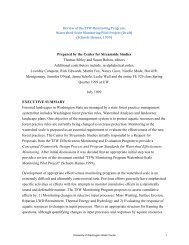Copyright 2012 Aileen M. Echiverri-Cohen - University of Washington
Copyright 2012 Aileen M. Echiverri-Cohen - University of Washington
Copyright 2012 Aileen M. Echiverri-Cohen - University of Washington
You also want an ePaper? Increase the reach of your titles
YUMPU automatically turns print PDFs into web optimized ePapers that Google loves.
Spinella & Miley, 2004) were examined as possible covariates to help and reduce error variance<br />
and obtain a more powerful test (Tabachnick & Fidell, 2001). Based on the small correlations<br />
between the potential covariates and inhibition measures, no covariates were included in the<br />
main analyses. However for the exploratory analyses examining pre-treatment inhibition as a<br />
predictor <strong>of</strong> changes in psychopathology, age showed significant correlations with pre-treatment<br />
inhibition and was therefore included as a covariate for AB.<br />
Power Analysis<br />
Power analyses were based on a general linear model framework based on the observed<br />
effects seen with each <strong>of</strong> the four specific aims. The general linear model framework provides<br />
slightly more conservative power estimates compared to longitudinal model frameworks such as<br />
mixed effects modeling. The increase in power for mixed effects models depends on with<br />
magnitude <strong>of</strong> the magnitude <strong>of</strong> the within subject correlation such that power ranges between<br />
the estimates derived in the general linear model framework to 100% power.<br />
Power in the present study was most constrained by the first hypothesis, comparing two<br />
treatment modalities (PE vs SER) on AB and PPI from pre-to post-treatment, and the third<br />
hypothesis, examining the ability <strong>of</strong> pre-treatment inhibition (AB: L1, L2, L3, L4, L5; PPI: 30<br />
ms, 60 ms, 120 ms) to predict changes from pre- to post-treatment and follow-up on<br />
psychopathology and functioning.<br />
For the first hypothesis, with respect to the treatment modality x time interaction, the<br />
sample size <strong>of</strong> two groups (SER: 29 and PE: 20) yielded 77.1% power to detect a significant<br />
interaction when the interaction is a disordinal effect. A disordinal effect means the treatment<br />
effect is in opposite directions between the two treatments with effect sizes <strong>of</strong> 0.8 for each<br />
treatment contrast and the two levels <strong>of</strong> the predictor.<br />
29
















